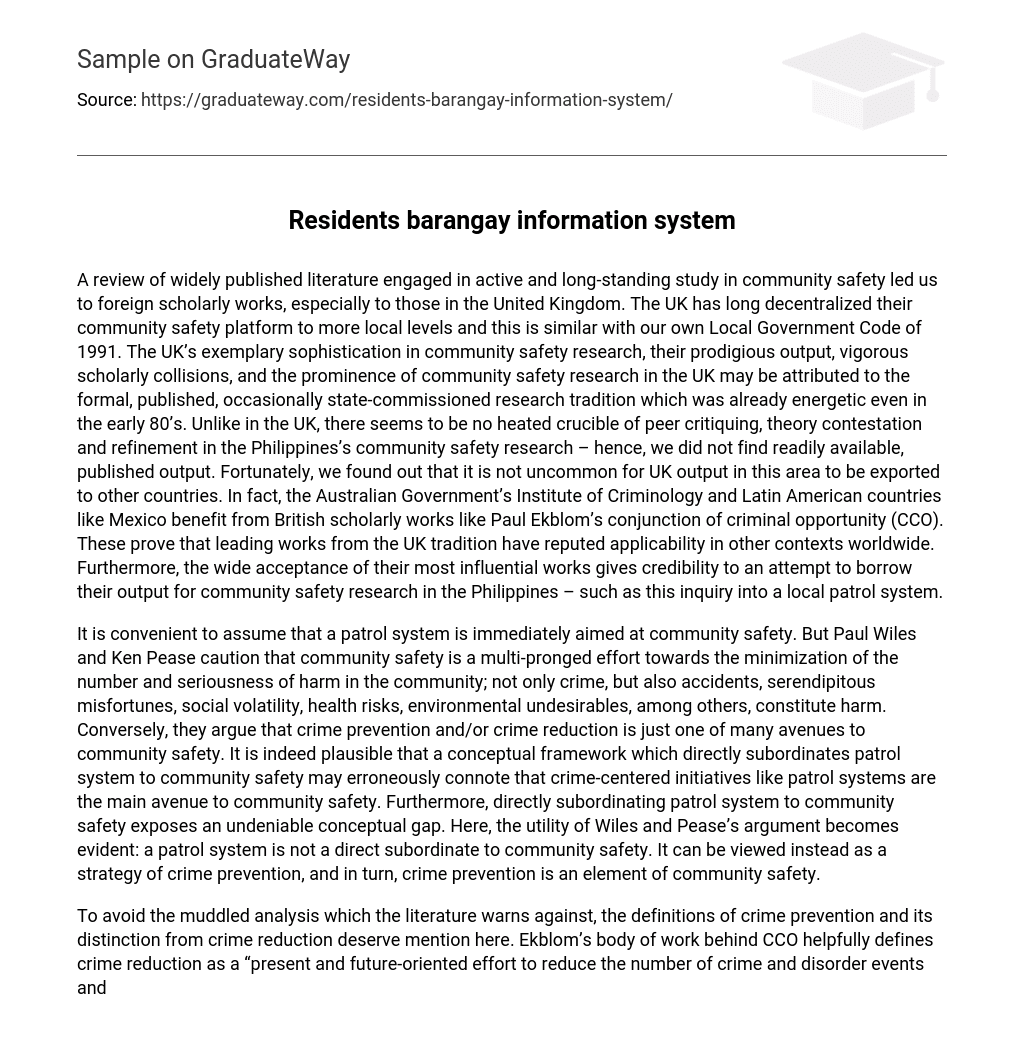After examining a range of published literature on community safety, we discovered that the United Kingdom (UK) has extensively researched this field. The UK has a decentralized approach to community safety, similar to our own Local Government Code of 1991. The UK’s commitment to community safety research can be attributed to their history of formal, published research, which dates back to the 1980s. In contrast, the Philippines lacks a strong tradition of peer critiquing and theory development in community safety research, resulting in limited access to published works. However, we were pleased to learn that UK research in this area is often shared with other countries. For example, the Australian Government’s Institute of Criminology and Latin American nations like Mexico benefit from British studies such as Paul Ekblom’s criminal opportunity (CCO) theory. This demonstrates the global applicability of leading UK works in the field of community safety.Moreover, the credibility of attempting to use their output for community safety research in the Philippines, such as this investigation into a local patrol system, is reinforced by the widespread acceptance of their most influential works.
The assumption that a patrol system is solely focused on community safety is convenient, but Paul Wiles and Ken Pease warn that community safety encompasses more than just crime prevention. It also includes reducing accidents, unexpected misfortunes, social instability, health risks, and environmental hazards. They argue that crime prevention is just one aspect of community safety and that it is possible to mistakenly view patrol systems as the primary means of achieving community safety. They highlight a conceptual gap when patrol systems are directly subordinate to community safety. Therefore, Wiles and Pease propose that a patrol system should be seen as a strategy for preventing crime, which itself contributes to overall community safety.
To avoid confusion, it is important to discuss the definitions of crime prevention and crime reduction. According to Ekblom’s work on Crime Control Strategies (CCO), crime reduction refers to efforts that aim to decrease the number and severity of crime and disorder events by directly intervening in the events and their causes. On the other hand, crime prevention focuses on future-oriented actions that aim to reduce the risk and potential severity of crime and disorder events by intervening in the underlying causes. Crime reduction deals with ongoing issues and even involves intervening during a crime event, while crime prevention aims to anticipate and prevent crimes from occurring in the first place. However, in practice, most crime reduction efforts also involve preventive measures. Similarly, successful crime prevention strategies primarily aim to proactively prevent crime and thus reduce its occurrence. Ekblom specifically identifies patrolling as a crime prevention measure.
The framework developed by Paul Ekblom is a widely-adopted concept in the field of community safety, both within and outside of Europe. It is a significant contribution that should not be overlooked. Ekblom’s framework combines the causes related to both the situation and the offender, ultimately leading to a crime or disorder event. This framework identifies 11 pre-cursors of crime and offers corresponding interventions for each one. The literature also highlights factors that have been found to be crucial for success in practice. According to Ekblom, capacity building is essential and should be supported by technical knowledge, equipment, financial resources, leadership skills, and access to crime preventers, among other elements. In contrast, Leslie Silverlock and Julia Stafford propose a more concise approach, stating that funding, standards, training, and partnerships increase the likelihood of success.
Interestingly, other studies also support Stafford and Silverlock’s claim about the significance of partnership. Scott Ballintyne and Penny Fraser back this assertion with evidence, stating that involving stakeholders in consultation and dialogue can enhance the effectiveness of community safety initiatives.
This section dealt exclusively with literature that is directly relevant to the development of the conceptual framework for this case study. We will introduce additional relevant literature as necessary. You can find more information about this by visiting http://astudyofbarangaylittlebaguio.blogspot.com/2009/01/review-of-related-literature.html on the resident information system.





